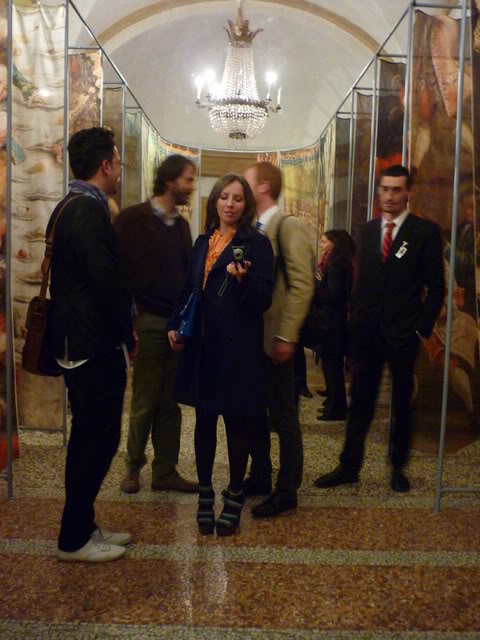for the threat to expose another agent's identity.
It's funny how spectators of art so often take 'truth' for granted. If someone whacks a shark in a box of formaldehyde and says it's art, we believe that not only is it a real shark in real formaldehyde, but also that it's real art, provided it's in a gallery setting of course. If an artist says that the ashes in a pile in the corner of the gallery resulted from a wind shelter they exploded with a hand grenade, we believe that as well. It wasn't until I went to check out Jill Magid's show at the Tate Modern that I realised how much we were willing to accept at face value.
Though Jill Magid's exhibition at the Tate Modern is in the little gallery on level 2 and hasn't been promoted well or reviewed much, it's the most interesting exhibition I've seen in the TM since Cy Twombly's exhibition in 2008. As a viewer, I'm very intrigued by the idea of Magid's work, her commission with the AIVD - the Dutch Intelligence and Security Agency, the country's secret service - and the restrictions placed on the artist about showing the work, but the very nature of the work itself made me surprisingly sceptical.
It's a very small show, but it took less than 5 minutes of wandering around before I begin to wonder whether I was being had. Was this exhibition a true reflection of the artist's actual experience or was it simply that a very clever individual had dreampt up a fantastic conceptual framework which resulted in some pretty words scrawled in neon light. I've since done a bit of research and it seems that Magid did have a commission with the AIVD and worked with them from 2005 to 2008. Under regulations - which similarly exist in parts of the UK - stipulating that new buildings must provide an element which engages with the arts, usually a public sculpture, she won the commission. It sounds like an initially forward thinking AIVD hired Magid to find the 'human face' of the organisation, only they got a bit more than they bargained for. She carried out her commission by meeting privately with a number of agents and collecting personal data about them and their experiences working as agents in the secret service.
In fact, Magid herself requested to be vetted by the agency and was eventually granted security clearance. Her exhibition speaks strongly of her own desire to be part of 'the secret' and to act as an agent herself. Though no matter how close she got and what kind of access she received, what happened next only demonstrates how clear the divide is between 'us' and 'them'. In 2008, Magid was set to show the results of her commission at a gallery in the Hague, though the day before its opening, a group of AIVD agents showed up (sounds more like a film than real life!) to vet the work. Magid also gave the agents a copy of the manuscript of her novel - which she wrote in lieu of a report about the experience - which they later returned in a heavily edited form.
When Magid complained to the AIVD that the censored manuscript was no longer publishable, they brilliantly suggested that she show the manuscript in a one-time only exhibition, after which it would become the property of the Dutch government and not be published. What else do you expect when you undertake a commission for a secret service agency. Having said that, I think Magid, and the exhibition side-step the problematic issues surrounding permissions and secrecy beautifully and imaginatively. As Magid was obviously not allowed to reproduce photographic images of the agents, she had to think of another way to visually represent them. One of the ways she did so was to visualise language as a series of neon signs - these are words or phrases the agents said during their interviews - which are then written in neon in her own handwriting.
 Exploring the negative imapact of a highly intrusive surveilance society is one of the most overused tropes in contemporary art - it's usually presented in a screechy, obvious, in-your-face manner. Magid's work makes the same statement but uses an entirely different pack of cards: the message is so subtle and refined - mixed with an unexpected longing to be on the other side - that it takes until long after you've departed the exhibition to figure out what the real message is all about.
Exploring the negative imapact of a highly intrusive surveilance society is one of the most overused tropes in contemporary art - it's usually presented in a screechy, obvious, in-your-face manner. Magid's work makes the same statement but uses an entirely different pack of cards: the message is so subtle and refined - mixed with an unexpected longing to be on the other side - that it takes until long after you've departed the exhibition to figure out what the real message is all about.PS While you're at the Tate, make sure to check out the Miroslaw Balka's work in the turbine hall. It's great fun!







No comments:
Post a Comment